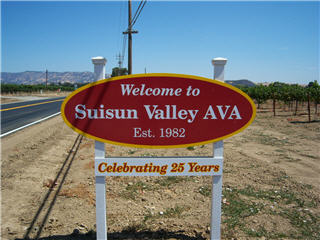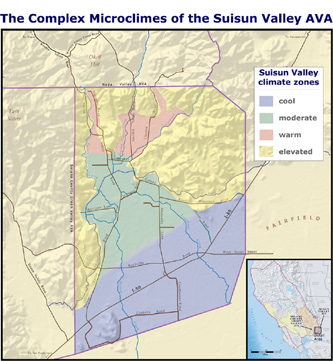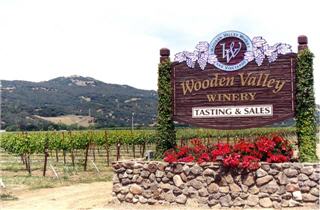 At the southeast corner of California's North Coast AVA, Suisun Valley is the little AVA that could.
At the southeast corner of California's North Coast AVA, Suisun Valley is the little AVA that could.
Suisun Valley: The California North Coast’s Forgotten Gem
With its wide-ranging climate and grape-growing know-how, Suisun Valley was bound for wine making stardom. It has just taken awhile. The wait is over.
by Clark Smith
August 18, 2008
 irst the basics. It’s “Suh-SOON.” This underappreciated enclave tucked into the Fairfield Gap, east of Jamieson Canyon and south of Wooden Valley, home to a handful of Don Quixote winegrowers and an experimental hotbed which has already resulted in a smattering of world class wines and more than a few of the best bargains in the North Coast, has been the secret weapon of several Napa producers for decades.
irst the basics. It’s “Suh-SOON.” This underappreciated enclave tucked into the Fairfield Gap, east of Jamieson Canyon and south of Wooden Valley, home to a handful of Don Quixote winegrowers and an experimental hotbed which has already resulted in a smattering of world class wines and more than a few of the best bargains in the North Coast, has been the secret weapon of several Napa producers for decades.
The current bottom line is this. Today smart shoppers would go to Suisun to buy Sauvignon Blanc and Petite Sirah. They would buy A LOT of these two varietals because they are not only often terrific values but among the most distinctive and enjoyable in the State.
But for wine geeks like me, the real adventure lies ahead. Kept barefoot and pregnant by major wineries throughout the 20th Century, Suisun is only now beginning to explore its potential and to find its identity. We are in the midst of a Forrest Gump moment when the future is unfolding before our eyes, and for my money, the great wines this region is capable of haven’t been made yet.
There’s another reason to visit Suisun, which is that these guys are the real deal – salt-of-the-earth growers.
The Geography - This eight mile long bifurcate Valley possesses all of the climatic diversity of Napa. It can’t be thought of as one terroir, but is separated into four distinct climatic zones. Ongoing studies by vineyard climatologist Dr. Paul Skinner show that despite its proximity to Suisun Bay, the cooling influences of prevailing winds do not come from there but from easterly breezes from Jamieson Canyon.

Within the Suisun Valley appellation exists a wide range of growing conditions, making the region suitable for a host of varietal choices ranging from cold-loving varieties like Pinot Noir, to warm climate ones like Cabernet, Zin and Petite Sirah.
(click on map to enlarge)
The coolest zone is the exposed southern flats above and below Interstate 80, which are chilled by cooling easterlies, and the heavy alluvial soils permit only the most cold-loving varietals such as Pinot Noir to mature. The mid Valley is partially shielded by its 400-foot western escarpment, and can bring in cool climate Rhône varietals and Sauvignon Blanc.
Up valley sites in the Upper Suisun Valley (west fork) and Gordon Valley (east fork) resemble Calistoga’s Region 3 climate, and are more suitable for Bordeaux varieties. But our tasting indicates that the fourth terroir shows the most promise, the elevated terrain above the valley floor which is just beginning to be explored for intense, minerally Cabernet, Zinfandel and Petite Sirah. In all these zones, fog is not an issue. Full sunshine all the time suppresses rot and mildew, suggesting great potential for organic practices, although it also can lead to elevated sugar levels at ripeness.
History - Savvy consumers who taste Suisun’s great wines will ask, “Where have you been all my life?” Well, right there in your glass. For decades this obscure region has invisibly provided the combination of quality and economy which has made the blends and price point formulas of North Coast brands work.
Until quite recently, Suisun has been home to growers rather than wineries. Because of their dependency on outside grape sales, the valley has twice suffered cycles of boom and bust.
Its life’s blood has been grape sales to prestigious wineries over the hill who possessed no wish to establish Suisan's reputation, but rather to benefit from the combination of high quality fruit and low per-ton pricing by keeping the local farmers under the radar. Since this is the way all other crops are grown in this country, it’s not surprising that these earnest growers were caught flatfooted by hiccups in the supply chain. Because of their dependency on outside grape sales, the valley has twice suffered cycles of boom and bust.
In the late 1950’s, when California began to move away from port and sherry production and into a table wine focus, a planting expansion led by Chic Lanza and Al Abruzzini (son of Beringer winemaker Fred Abruzinni) supplied Napa wineries, especially Christian Brothers, with Chenin Blanc, Zinfandel and Grey Riesling which were bottled as Napa Valley wines. Although Suisun is not in the Napa Creek watershed, neither is most of eastern Napa County, including Pope Valley, Chiles Valley and Wooden Valley, which is itself merely a northern extension of Suisun Valley.
By 1970, lower Suisun, mostly near Cordelia Junction, was solid grapes, planted there because the ground was too marginal for orchard crops such as pears and prunes, for which the upper Valley was reserved. As in the vineyards of Europe, grapes were a way to exploit cheap land, which had no other use.
Perplexingly, BATF in 1982 clamped down on the use of the Napa Valley appellation for Suisun fruit, but failed to extend this logic to the non-Napa Valley portions of Napa County. Caught in the crossfire, Suisun growers had to grin and bear it as grape orders plummeted in preference to growers across the County Line.
Suisun’s next patron was Sebastiani, and by the late 1980’s, the whole region was planted, driven by contracts for thousands of tons of Napa Gamay, Cabernet Sauvignon, Zinfandel (“unique bramble flavor”) as well as Chenin Blanc and Green Hungarian, which disappeared into the Sonoma giant’s huge vats of North Coast fighting varietals. In the year 2001, the region was again devastated when Sebastiani shrank itself from 2 million cases to a tenth that size, and its Central Valley brands, picked up by Constellation, dropped the Suisun contracts. The simultaneous grape glut doomed perhaps 4,000 tons to be left hanging, while Gallo scooped up fruit for $150 a ton.
Even today, 96 percent of Suisun’s fruit is exported. But now the movement is away from the big boys and more and more geared to relationships with small, quality-oriented wineries, especially those interested in featuring the appellation on their labels. A growing percentage of these are outside California, including the prestigious Biltmore Estate, Napa maverick genius Matthew Rorick of Forlorn Hope, and the dynamic Sauvignon Blanc mega-boutique Manifesto.
Local production is building, too. A decade ago, there were three local wineries. Now there are ten. Approaches run the gamut from the Lanza

One of the pioneer wineries in Suisun Valley, Wooden Valley Winery had one of the first tasting rooms for visitors in the area.
 READER FEEDBACK: To post your comments on this story,
click here
READER FEEDBACK: To post your comments on this story,
click here
Print this article | Email this article | More about Suisun Valley | More from Clark Smith
Best-of-Appellation (BOA) Wines
31 wines were advanced to the BOA Lists in this round of evaluations from the following appellations; California, Solano County, Suisun Valley
About the BOA Program & Evaluators
Find out more about the Best-of-Appellation Program and meet our BOA Evaluators. click here










